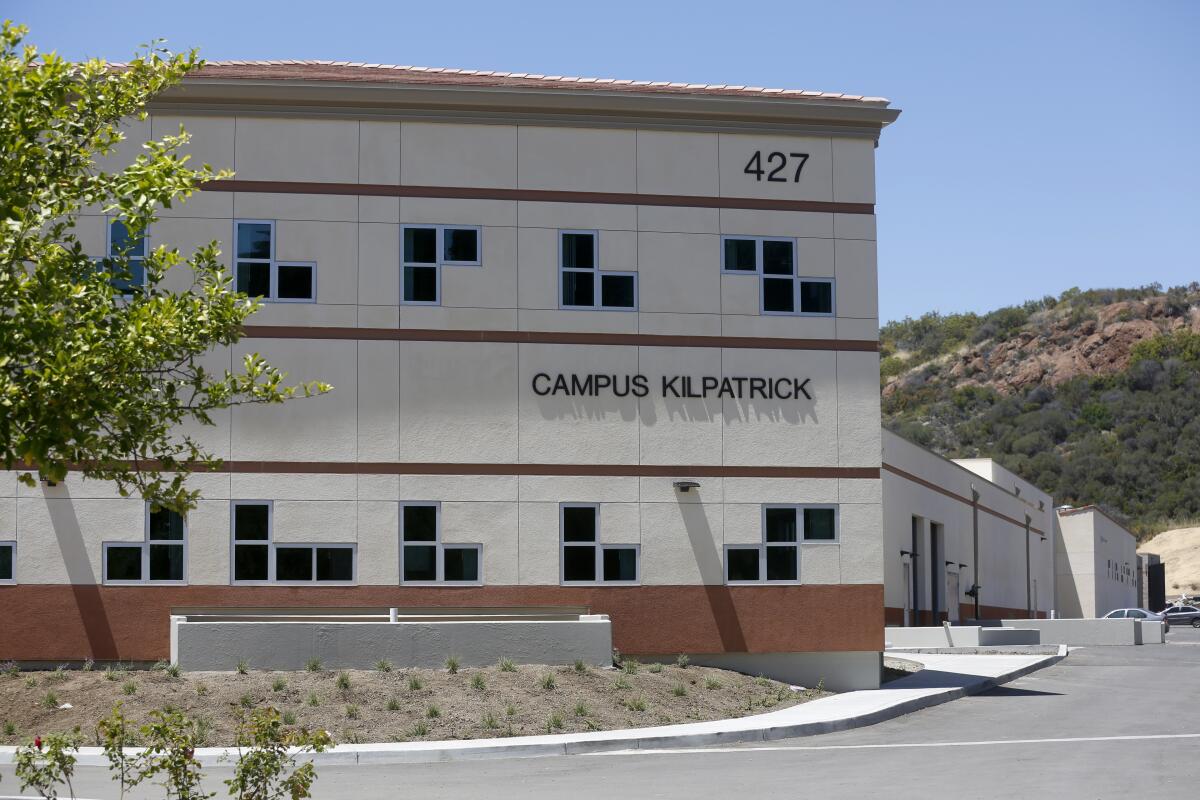Editorial: The ‘L.A. Model’ of juvenile rehabilitation: Great in theory, untested in real life

- Share via
Nearly a decade ago, juvenile justice leaders and L.A. County officials borrowed ideas from programs in Missouri and Santa Clara County and designed a therapeutic approach to juvenile rehabilitation to replace the prevailing, and failing, boot-camp-style system. They spent more than $50 million to raze an old probation camp in Malibu and replace it with a state-of-the-art campus that featured small residential units instead of barracks and plenty of space for care and counseling. County leaders were so hopeful about their new program and facilities that they dubbed it the “L.A. Model” and expected other counties to study and imitate it.
Campus Kilpatrick opened for its first group of juveniles in 2017.
Four years later, Gov. Gavin Newsom is closing the Division of Juvenile Justice, the state system of youth prisons to which counties once sent their most difficult cases. Beginning this month, counties will have to handle the toughest cases themselves.
The Board of Supervisors contend that L.A. County is uniquely positioned to deal with the new population because it has Campus Kilpatrick — and the L.A. Model. The board had wisely commissioned a study of both so that an early evaluation of the first few years could identify strengths and weaknesses, and prepare the county to expand any successes across its entire juvenile probation system.
But the report was delayed, first by the county’s agonizingly slow and complex contracting process, and then by the Probation Department’s quibbling over how to design the evaluation. Then in 2018, the Woolsey fire forced Campus Kilpatrick to be evacuated. And then came COVID-19.
The evaluation report by the nonprofit Evident Change was finally presented to the county in December. So what were the findings?
Not good.
Or rather, we don’t know how the L.A. Model would have done, because it was never properly implemented. Important parts of the program were dropped because they conflicted with the county status quo. The small groups of youths could not, for example, benefit from consistent leadership from a single adult supervisor because of the odd workweek negotiated by the probation officers union (two 16-hour shifts and an eight-hour shift, separated by two eight-hours of sleep on site and then a long stretch at home). The arrangement meant a different probation officer for each group every 2½ days.
There was also high turnover among teachers, which were replaced by instructors not trained in the L.A. model. That lack of consistency was matched by changes in leadership at Campus Kilpatrick, and also among chief probation officers.
Training was insufficient. Three-quarters of staff couldn’t clearly articulate what was expected of them. There was no procedural manual until November. Juveniles were admitted at a faster pace than the model called for. Many staff trained in the L.A. Model did not follow the youths to Lancaster, where they were reassigned after the fire.
There continued to be too little support to families upon the juveniles’ return home. Arrests continued — more than 50% of youths were arrested again, although the numbers cannot be relied upon because of problems with data collection.
The findings are all quite troubling, but not necessarily surprising. In an Aug. 2, 2018, letter to probation officials, Probation Commissioner Jacqueline Caster detailed a host of problems she encountered on a visit to Campus Kilpatrick, including group sizes far in excess of those contemplated by the L.A. Model, juveniles undergoing treatment with psychotropic medication being improperly assigned to the camp, and deviation from the approved therapeutic methods.
“In national juvenile justice circles,” Caster wrote, “experts are increasingly aware of the Los Angeles Probation Department’s inability to operate the facility with basic adherence or fidelity toward its own carefully-developed plans.”
The Woolsey fire laid bare additional problems, as discussed in a remarkable series of stories by Celeste Fremon of WitnessLA. Evacuation was delayed too long as camp staff awaited orders from headquarters. Cars wouldn’t start. Garden hoses were locked in storage and no one on site was entrusted with the key, so staff could not put out the small fires started by flying embers. In the end, some of the youths and staff were evacuated, but others didn’t leave in time and instead sheltered in place.
In any large bureaucracy there can be dangerous gaps between vision and execution, and Los Angeles County is as large as bureaucracies come. The county unnecessarily exacerbates its problems with a very short attention span, allowing its leaders to believe they have accomplished things that they have merely discussed. That’s the case with the L.A. Model of juvenile rehabilitation. It’s not ready for an influx of teenagers who formerly would have been sent to the state for supervision. Does the model work? We don’t know. Apparently, it hasn’t actually been tried yet.
More to Read
A cure for the common opinion
Get thought-provoking perspectives with our weekly newsletter.
You may occasionally receive promotional content from the Los Angeles Times.










